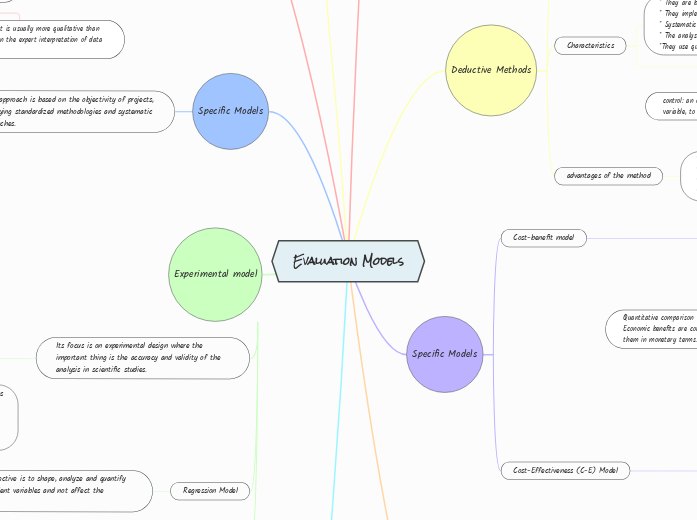Evaluation Models
Analytical Models
Its main basis is to provide clear and scientific descriptions obtained through quantitative observation.
Key Points Used
Data Collection
* Cause-and-Effect Approach between Different Variables
* Objectivity
* Detailed Data Analysis
Benefits of the analytical model
* Accuracy and objectivity
* Suitability for making predictions
* Variable causal relationships
* Comprehensive evaluation
* Improved progress in decision-making
Deductive Methods
They are implemented to explain the functioning of a project or phenomenon by infusing behavioral laws, especially in the social context.
Characteristics
* They are based on universal principles and laws.
* They implement experimental control methods.
* Systematic observation.
* The analysis of data correlations. *They use quantitative and statistical data.
It can be developed in 3 fundamental steps
control: an observation is made of the effect on each variable, to finally relate the causes to the environment.
Systematic observation: Analyze and construct a development of phenomena without altering the environment through specific guidelines in natural conditions.
Correlation of variables:
Through statistical analysis, the relationships between different variables are studied to determine if there is any correlation between them.
advantages of the method
*Clear and logical descriptions
*Supervision and accuracy
*Transfer of results
*Ability to identify causes and effects that link results.
Specific Models
Cost-benefit model
It is implemented to determine whether the project is economically feasible and which of its benefits are profitable.
key points for its implementation
Quantitative comparison
Economic benefits are compared with costs, presenting them in monetary terms.
Profitability measurement: its objective is to analyze benefits and costs through profitability (RI) or net present value (NPV).
The benefits achieved: financial clarity
* Evaluate project profitability,
* Ease of comparison between projects with different costs and benefits
* Boosts investment by justifying expenses against potential revenue
Economic direction
Provides key data for assessing the financial viability of a project
Cost-Effectiveness (C-E) Model
It is used when the benefits are not monetary, but rather measured in terms of a unit of effect, in order to compare costs and obtain the best results with the lowest investment.
Structure of the method
Use in projects with non-financial aspects
achieves the desired objective at the lowest cost and maximizes the impact of the investment.
Maximize effectiveness by using resources optimally
Semi-Formalized Models
Its approach is quantitative through flexible structures for the realization of variables
Leveraging qualitative and quantitative data
Through more comprehensive and integrated analysis, utilizing both quantitative and qualitative data for a more holistic view.
Model After
Its main focus is to focus on evaluating the results only after an intervention, without the need for a comparison group
Time Series Its function is to evaluate variables over time,It facilitates the making of predictions based on the evolution of past data.
Non-Experimental Model Before and After
It is useful for evaluating the impact of an action without the need for strict control of variables and focuses on using few resources.
Model After with Comparison Group Model After with Comparison Group
Compare results with a similar group after the intervention
characteristics
Flexibility Applicable to situations where it is not possible to experiment with total control of variables
Illuminative Model
Its objective is cultural understanding and an in-depth evaluation of project processes.
Cultural approach: Seeks to understand the different values, beliefs, and cultural contexts that influence project outcomes.
Interpretation and understanding: focuses on subjective social analysis, encouraging deeper reflection on their coexistence.
CIPP Model
For its successful implementation it uses 4 bases
Context: Investigate the context
Inputs: Allocate resources
Process: Structural development of the project
Output: Results and impacts achieved in the project
Targeted Utilization Model
It focuses mainly on the evaluation of individuals to determine whether the results were effective.
User Guidelines:
Seeks to involve project users in the evaluation to deliver responsible results.
Appropriate methods Specific evaluation methods are chosen to facilitate decision-making between qualitative or quantitative methods.
Expert Evaluation Model
This model is based on the judgment and experience of experts in a specific field
Expert: They draw on their experience to delve deeper into the assessment to provide relevant results.
Qualitative evaluation: It is usually more qualitative than quantitative, focusing on the expert interpretation of data or situations.
Specific Models
Their approach is based on the objectivity of projects, employing standardized methodologies and systematic approaches.
Characteristics of Formalized Evaluation Models
*Standardization
*Concentration
*Authenticity
*Continuous assessment
*Adaptability
Experimental model
Its focus is on experimental design where the important thing is the accuracy and validity of the analysis in scientific studies.
importance of its benefits
*Absolute direction of guided environmental variables
*Structures executed step by step with precision
*Clear and simple objectives
*In-depth research analysis to locate variables
*Exact results
Regression Model
Its main objective is to shape, analyze and quantify the independent variables and not affect the statistics.
Point predictions: Facilitates prediction of the behavior of the dependent variables.
Rigorous analysis: Provides a detailed understanding of the different factors that influence the results.
Quasi-Experimental Model
The main objective of this model is to isolate the causal effects of the manipulated variable, reducing external factors that could distort the results.
* Group comparison: An experimental group is compared to a control group without complete manipulation of the variables. Field observation: Conducted in natural or less controlled environments.
Global Models
Its main focus is on a qualitative model, more social in the experiences and perceptions of participants to achieve its objectives.
The characteristics are divided into three approaches
Holistic approach
considers both tangible and intangible aspects, and quantitative measurements as a whole.
Non-causal:
Its focus is on the actions or overall impact of the participations, without isolating variables.
Qualitative information
This information is based on qualitative data, such as interviews, focus groups, and direct observation, to provide more accurate information during project development.
